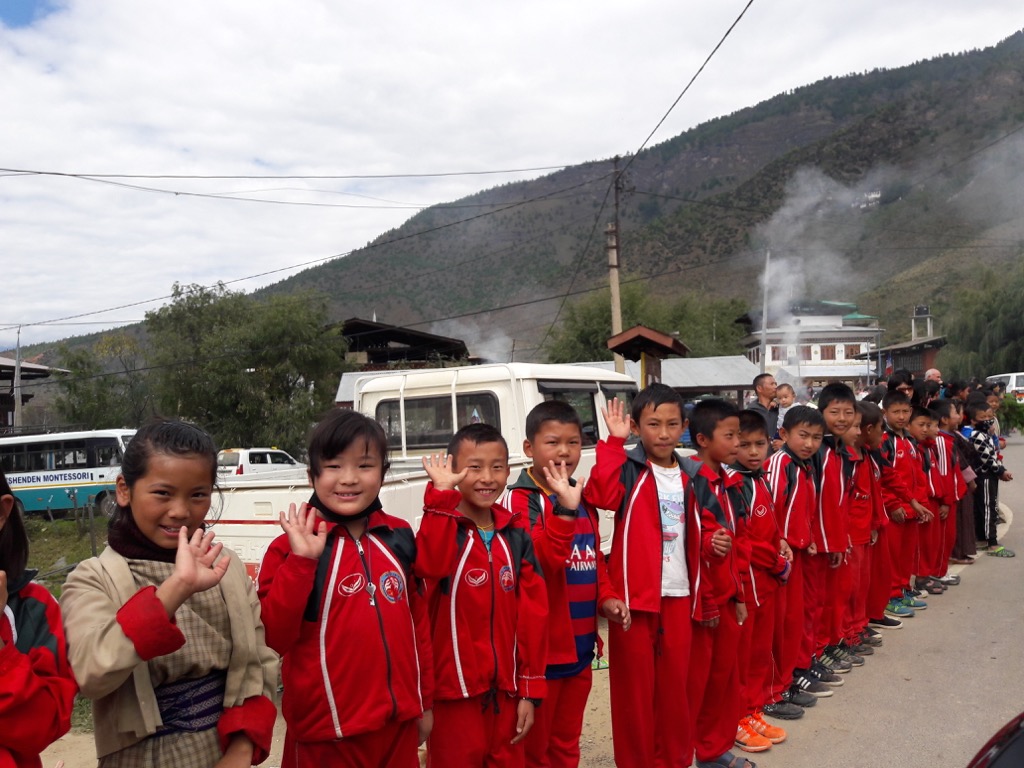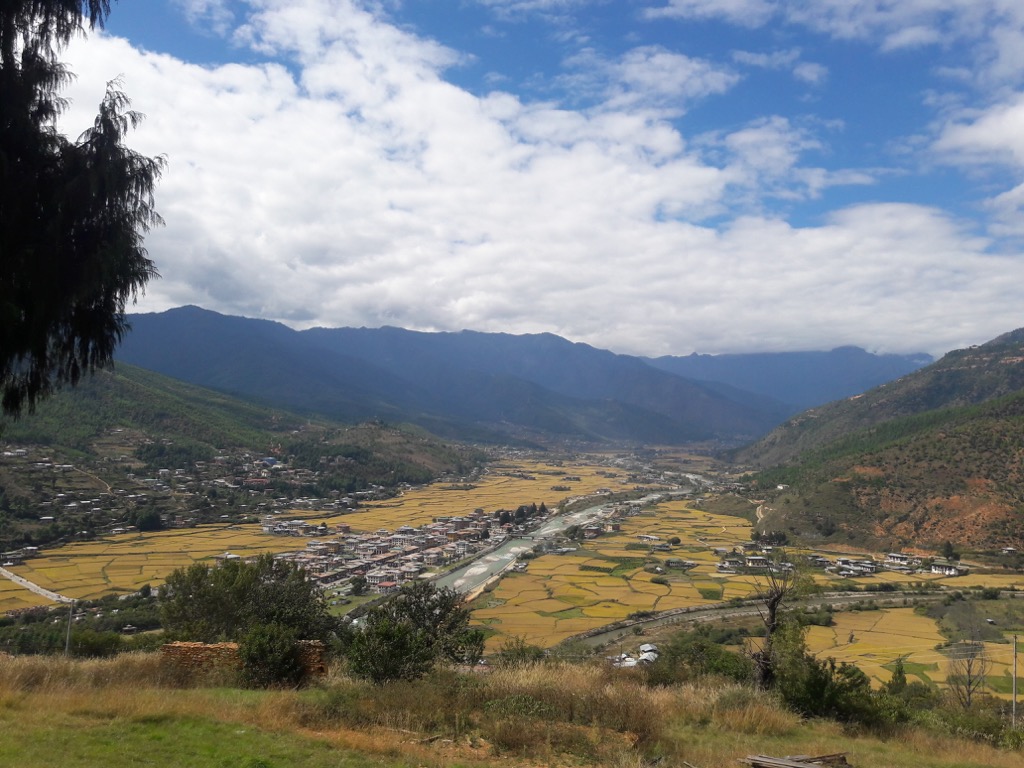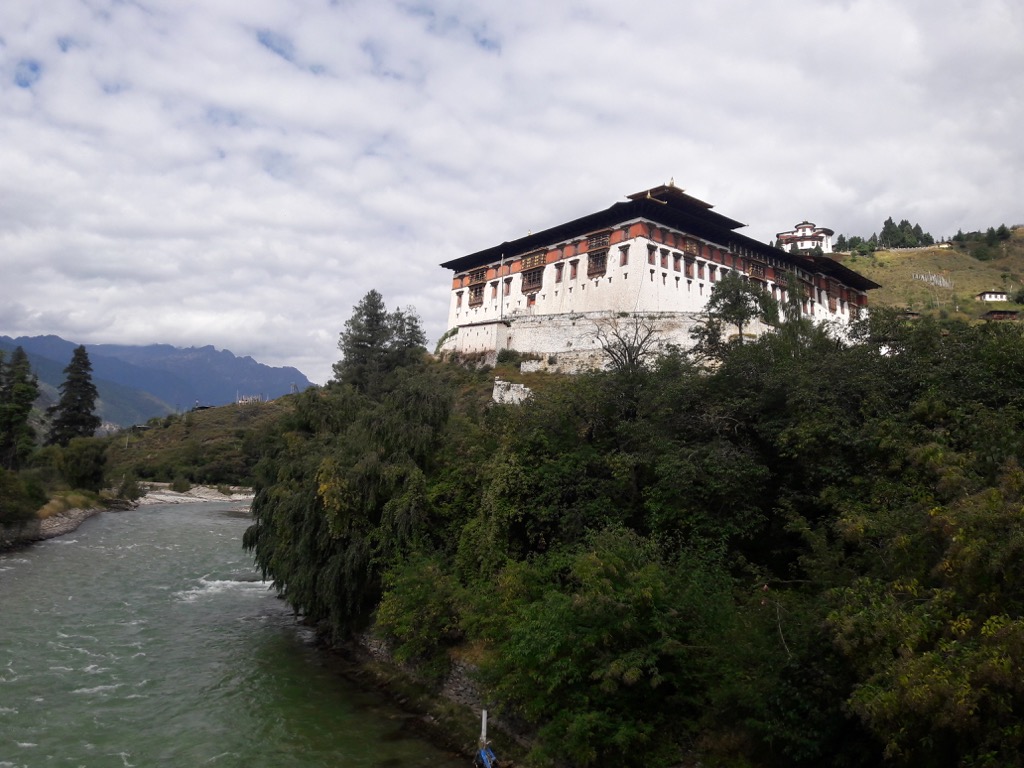Bumthang Ura Festival (Ura Yakchoe)
|
|
Ura valley in Bumthang is known for the famous dance known as the Ura Yakchoe. The mask and folk dances are performed during and also sacred relic is put on display so that the people can receive blessings from it.
According to legend, a lama visited an old woman who was sitting outside her house. This Lama seemed very mysterious and all he asked from the old lady was a glass of water. The old lady went to get water for the lama and when she returned the Lama just disappeared. But left behind a sack outside her doorsteps. Out of curiosity,she opened the sack and found a statue in the sack. The statue was no ordinary statue, for it was a relic which is now displayed annually during Ura Yakchoe. This relic has been passed on from generation to generation and is still owned by the descendants of the woman.
10 Night 11 Day Tour Itinerary

Day 1 Arrive at Paro,Paro-Thimphu (54 km-1 hour drive)
If you arrive on a bright sunny day, your holiday began with the panoramic view of the Himalaya range from your flight seat, you will be greeted by Mt. Everest and Mt. Kanchenjunga, and our very own Mt.Jomolhari and Mt.Jichu Drakey. An unparalleled feeling while you are descending over Bhutan is a feeling which is of total abandonment, a feeling which is inexplicably, compassionate and full of suspense as visibly seen in the growing communion between the passengers.
Upon arrival you will be received by our guide who will help you settle into your comfortable car and will be heading to capital city Thimphu.
Check into the hotel. After your lunch visit the following places.
Tashichhoe Dzong, a fortress of the glorious religion. It was built in 1641 by Zhabdrung Ngawang Namgyel and was reconstructed into present structure by the late King, His majesty Jigme Dorji Wangchuck in the year 1962-1969. It houses the secretariat building, the throne room and the office of the king, and the central monk body.
Government-run Handicrafts Emporium and local crafts shops, to browse through examples of Bhutan’s fine traditional arts. Here you can buy hand-woven textiles, thangkha paintings, masks, ceramics, slate and wood carvings, jewelry, and other interesting items made from local materials.
Dinner and overnight at a hotel in Thimphu.
Day 2 Thimphu Sightseeing
After breakfast visit the following:
Kuenselphodrang where largest Buddha statue in the country is perched on the hillock overlooking the Thimphu valley and also if interested/if time permits, take a leisure walk through Kuenselphodrang Nature park and enjoy the nice view of the entire Thimphu valley below.
Bhutan Post Office Headquarters to get personalized Bhutanese postage stamps with your photo on them. You can bring along your favorite photo to put on the stamps and put these stamps on your postcard to send to your family and friends.
National Textile Museum which is a good place to see the art of traditional weaving being kept alive and preserved through exhibition and has a good collection of old textiles which are rich in colors and designs. You will also see people weaving with intricate designs.
Traditional Bhutanese paper making factory. The handmade paper making in Bhutan stemmed from the age old tradition originated in 8th century of Bhutanese history. The handmade paper constitutes as valuable National heritage of Bhutanese cultural identity and is preserved through all the ages. The Traditional paper is recognized and held high esteem both in home and outside world. Jungshi Paper Factory was established in November 1990 as an undertaking of the Royal Government of Bhutan. The unit now boasts as a major and sole dealer in handmade paper and its products.
After lunch visit the following:
National Institute of Traditional Medicine(outside only), where medicinal herbs are compounded and dispensed, and traditional medical practitioners trained.
The School of Traditional Painting of Arts and Craftswhere students undertake a six-year course on the 13 traditional arts and crafts of Bhutan.
Takin Preserve, which houses the national animal the Takin that is only found in Bhutan. This is an extremely rare member of the goat family. Found in herds in the very high altitudes (13,125ft and over). They live on a diet of grass and bamboo. It can weigh as much as 550 pounds.
National Memorial Chorten (stupa), chorten literally means ‘ seat of faith’ and Buddhists often call such monuments the ‘Mind of Buddha’. Meet the elderly generation in circumambulation at the National Memorial Chorten.
In the evening stroll around Thimphu town where you can visit local handicraft stores.
Dinner and overnight at a hotel in Thimphu.
Day 3 Thimphu-Punakha (77 km-3 hours drive)
After early breakfast, you will drive towards Punakha via Dochula Pass.

Dochula pass is located on the way to Punakha from Thimphu. The pass is popular for tourists for its ideal location from where one can enjoy 360 degree of beautiful panoramic view of Himalaya mountain range, especially on clear winter days. The beauty of this place is further enhanced by the Druk Wangyal Chortens-108 stupa built by the eldest Queen Mother Her Majesty Ashi Dorji Wangmo Wangchuk. The pass is also popular spiritual place for both locals and tourists because of an important temple that is located on the crest of Dochula pass.
Her Majesty Ashi Dorji Wangmo Wangchuck has achieved a fine blend of history and mythology in the construction of The Druk Wangyal Lhakhang (temple) to honor His Majesty the fourth Druk Gyalpo, Jigme Singye Wangchuck. The past and future appear to merge in the details of the lhakhang (temple) that tells the story of a supreme warrior figure whose vision pierces the distant future.
Besides the spirituality of the place many Bhutanese families visit the pass during holidays and weekends to simply enjoy the scenery of the place with their pack lunch and hot tea. For the tourist the place is an ideal location to capture beautiful pictures of Himalaya mountain range during clear warm days.
Punakha Dzong
Placed strategically at the junction of the Pho Chu and Mo Chu rivers, the dzong was built in 1637 by Zhabdrung Ngawang Namgyal to serve as the religious and administrative seat of the region. It was here that the dual system of government was introduced in the 17th century and in 1907, enthroned the first King Gongsar Ugyen Wangchuck. Damaged over the centuries by four catastrophic fires and an earthquake, the dzong has been fully restored in the recent years by the 4th King Jigme Singye Wangchuck. At the dzong enrich your trip with the opportunity to see the highest standards in woodwork. Do not miss the massive Kuenray, the Coronation Hall of all Bhutanese kings, the Dzongchung at the entrance to the dzong and the cantilever bridge over the Mochu that has been recently renovated.
Chimi Lhakhang
The Chimi Lhakhang, situated on a hillock in the centre of the valley, is dedicated to Lama Drukpa Kuenley, who in the late 15th century used humour, songs and outrageous behavior to dramatise his teachings and due to this also known as “Divine Madman”. This temple is also known as the temple of fertility. It is widely believed that couples who do not have children and wanting one, if they pray at this temple, they are usually blessed with a child very soon. It is about 30 minute walk across field from the road to the temple. The trail leads across rice fields to the tiny settlement of Pana, meaning “field”. It then follows a tiny stream downhill to Yoaka and across more fields before making a short climb to Chimi Lhakhang.
Overnight in a hotel in Punakha.
Day 4 Punakha-Trongsa (130 km-5 hours drive)
After breakfast, travel to Trongsa with lunch served enroute. Trongsa is the ancestral home of the royal family. The drive will take you through dense forests of oak trees and rhododendrons and through the tropical vegetation through the village of Nobding and Pele la pass (11,000ft). Throughout your trip you will come across the beautiful sceneries of rural Bhutan, with scattered settlements far from the road which makes for good photographing.You will also pass through open meadows, and valley of yak herders and several other villages via Chendebji Chorten (Stupa). On arrival at Trongsa and after the refreshment visit the Trongsa National Museum which is housed in the Ta Dzong (watch tower). A museum in which aspects of Bhutanese culture and history are explained by beautifully objects. Documentary will be shown too which explains a great deal about Bhutanese history and history of monarchy.
You will also visit Trongsa Dzong,built in 1648 it is an architectural masterpiece and it is the most impressive dzong in Bhutan.
In the evening visit Trongsa downtown.
Dinner and overnight at a hotel in Trongsa.
Day 5 Trongsa-Bumthang(68km-3 hours drive)
After breakfast, drive to Bumthang, this is one of the most spectacular valleys in Bhutan and also the heartland of Buddhism. Here the great teachers meditated and left in their wake many sacred grounds. The Guru Rinpoche and his lineage of Tertons, treasure finders, have led to the sprouting of many temples in the valley. On the way, visit the “Yathra” weaving centre at Zugney and spend sometime interacting with the local weavers. Yathra is the name for the colorful, hand-woven woolen cloth (often with geometric designs) that is produced in this region and wool used for this type of textile is sheep wool as the sheep is reared in this Bumthang district.Yatra is made into jackets or bags ,etc. Then drive onto Bumthang and Check into hotel.
After lunch, Bumthang sightseeing includes visit to the following:
Jampa Lhakhang, built in the 7th century by the King Songtsen Goempo of Tibet. In his effort to propagate Buddhism, he had a plan to build a total of 108 temples in Tibet and neighboring kingdoms.
Kujey Lhakhang(Kujey means, “Body imprint”). The temple to the right is the oldest and was built by Minjur Tempa in 1652. It was built around the cave in which Guru Rimpoche meditated and left his body imprint.
Jakar Dzong, “castle of the white bird”. According to legend, when the lamas assembled in about 1549 to select a site for a monastery, a big white bird rose suddenly in the air and settled on a spur of a hill. This was interpreted as an important omen, and the hill was chosen as the site for a monastery and for Jakar Dzong. The fortress is now used as an administrative center of Bumthang district and summer residence of Trongsa monks.
In the evening stroll around the beautiful landscape of the Bumthang valley.
Dinner and overnight at a hotel in Bumthang.
Day 7 Travel to Ura Valley for Ura Yakchoe (Ura Festival)
After breakfast, you will travel to the historic village of Ura in the Ura Valley with packed picnic lunch. This intriguing village will delight you with its narrow cobble stoned streets and ancient houses. The people of this region are mostly Yak and sheep herders and the women of the village still wear the traditional white headscarves and sheepskin shawls. The shawls are used as a cushion and also as protection when they are carrying heavy loads.
You will attend the first day of Ura Yakchoe ( Ura Festival).The mask and folk dances are performed during and also sacred relic is put on display so that the people can receive blessings from it.
According to legend, a lama visited an old woman who was sitting outside her house. This Lama seemed very mysterious and all he asked from the old lady was a glass of water. The old lady went to get water for the lama and when she returned the Lama just disappeared. But left behind a sack outside her doorsteps. Out of curiosity,she opened the sack and found a statue in the sack. The statue was no ordinary statue, for it was a relic which is now displayed annually during Ura Yakchoe. This relic has been passed on from generation to generation and is still owned by the descendants of the woman.
You will enjoy your picnic lunch here and then after the festival you will travel back to Bumthang.
Dinner and overnight at a hotel in Bumthang.
Day 8 Bumthang-Wangdue via Phobjikha(197 km-7 hours drive)
After early breakfast, travel to Phobjikha valley through Trongsa and the dense forests of the Phobjikha Valley you arrive at Gantey village where you see the Gangtey Monastery and visit the monastery. Phobjikha valley is part of the beautiful Jigme Singye Wangchuck National Park ( formerly known as Black Mountains National Park), one of Bhutan’s most important nature sanctuaries. Each winter it is home to a flock of 300 rare and endangered black-necked cranes. The surrounding hills and mountains are home to nomadic shepherds and yak-herders. This is one of the most remote and untouched regions in Bhutan and is only just opening its doors to the outside world.
The Black necked cranes start migration to this area from November each year. You will have lunch at a resort/restaurant in this valley. Afternoon you can visit the Black Necked Crane Center and enjoy the fascinating sight of these birds in this beautiful scenic valley.
In the late afternoon drive back to Wangdue.
Dinner and overnight at a hotel in Wangdue.
Day 9 Wangdue-Paro(130 km-4 hours drive)
After breakfast travel to Paro and after lunch visit the following:
Rinpung Dzong,built in 1645 to defend the valley against Tibetan invaders. The Dzong is now being used as an administration center and school for monks.Then walk down to Rimpung Bridge (Traditonal Bridge), oldest bridge in Bhutan.
Farm houses in Paro Valley and a visit to a farm house offers a good glimpse into the lifestyle of a farmer.
Ta Dzong
One time watch tower built to defend Rinpung Dozng during inter-valley wars of the 17th century, since 1967 Ta Dzong is serving as the National Museum of the country. It holds fascinating collection of art, relics, religious thangkha paintings and Bhutan’s exquisite postage stamps. The museum circular shape augments its varied collection displayed over several floors.
In the evening walk around Paro downtown and you may visit local handicraft stores.
Dinner and overnight at a hotel in Paro.

Day 10 Hike to Tiger’s Nest
After breakfast travel by car to the base camp of Tiger’s Nest Monastery and then hike up to Taktsang Monastery, also known as ‘Tiger’s Nest’. The climb up to the viewpoint will take around 1 ½ hours and from there you will enjoy a spectacular view of the monastery clinging to the side of the cliff. Stop for refreshment at the View Point Cafeteria.Then walk further up to the monastery which will take another 1 ½ hour. It is said that in the 8th century Guru Rinpoche flew on the back of a tigress from eastern Bhutan to this place and meditated in a cave here for 3 months. The principal Lhakhang (monastery) of the present monastic complex dates from 1692. Taktsang was damaged severely by fire in 1998 but has now been fully restored to its former glory.After visiting the monastery, walk back down to the road on the way stop for lunch at the view point cafeteria and then walk further down to the road point.
On the way visit Kyichu temple,one of the 108 temples built in the 7th century by the Tibetan King Songsten Gampo. The story goes that a giant demon lay across the whole area of Tibet and the Himalayas and was preventing the spread of Buddhism. To overcome her, King Songtsen Gampo decided to build 108 temples, which would be placed on all the points of her body.
Dinner and overnight at a hotel in Paro.
Day 11 Departure from Paro
In the morning your guide will escort you to the airport for your flight onwards.